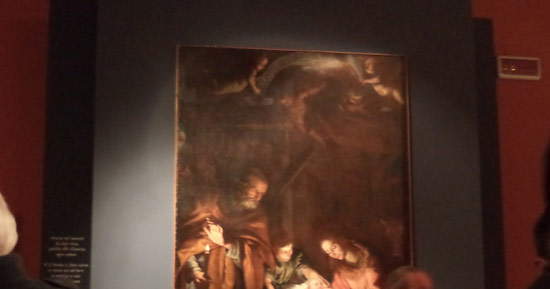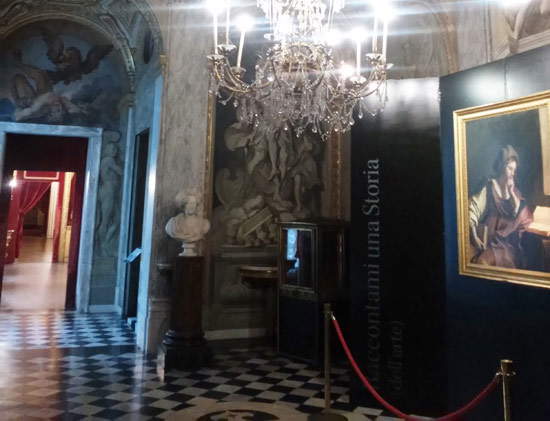I was pleased to read, in News-Art, Michele Cuppone ’sarticle on the display of Caravaggio ’s Flagellation in Monza. Not only because my book Un patrimonio da riconquistare (A Heritage to Regain) is mentioned in the article, but also and especially because Michele Cuppone wisely wanted to broaden the views of the piece in which, a few days ago, I had discussed the phenomenon of one-painting shows.
It is true: my article was certainly too limiting, in that I had avoided talking about those one-painting shows that are often necessary and obviously useful for advancing knowledge. Cuppone is right when he argues that an exhibition should be legitimized when it has scientific value. But, to quote Tomaso Montanari again, who has written dozens of pages on the issue of “useful versus useless exhibitions,” we need to add further elements of evaluation: that is, it is necessary to distinguish between “useful, beautiful and successful exhibitions” and “specious, harmful and failed exhibitions,” with the former being “those supported by an idea, a discovery, an acquisition, a historiographical vision or even the reconstruction of a historical or stylistic knot so relevant as to justify the movement of works.” It is clear that for Montanari an exhibition is successful when it is able to address both a specialist audience and a general public, although in actuality we are increasingly witnessing a kind of contrast between exhibitions that are incapable of speaking to the general public, and entertainment exhibitions that horrify experts. I really think that the main problem arises around the audience to which the exhibition is, in fact, addressed.
This antithesis between “experts” and “non-experts,” which in recent years has been artfully nurtured by those who have learned to organize exhibitions with a distinctly commercial flavor, probably lies at the root of the proliferation of all those entertainment products that are passed off as exhibitions with a high cultural profile. To appeal to a “non-expert” audience (and thus guarantee high results in terms of audience and quantity), it is known, is not particularly difficult, so much so that a very precise model has now been established, which has been followed for years by several companies specializing in the production of such exhibitions: a group of works by artists known to all and capable of exerting undoubted fascination (Michelangelo, Caravaggio, Impressionists, Frida Kahlo... ), you promote the event with strong and ubiquitous marketing, you leverage the strong emotions that the exhibition would be capable of arousing, you create side events by calling together personalities of great impact on the public (preferably those accustomed to appearing on television), while the exhibition is in progress you issue press releases at every turn announcing the various records of visits broken, and there you have it that any armeggione with the right connections, resourcefulness, commercial spirit and sponsors willing to subsidize the operation, can improvise himself as curator. And often all it takes to succeed is to enliven even a single work. Indeed: the one-painting show genre seems to be the one that has been in vogue lately, as it involves less risk, less expense, less effort, but equal success (also because one-painting shows are for the most part free admission: thus, in addition to having marketing campaigns insist on the event being free, curators can also boast of purposes that verge on the charitable).
It is not, however, about the biliously cheesy one-painting shows that I intend to talk about in this article: the reader can get a broader idea (and find several examples of useless ostentations) in the piece I had devoted to the topic a few days ago. I simply wanted to give an account, in order to avoid generalizations that do not do the subject matter any good, of some “one-work” exhibitions that were conducted in an unexceptionable manner and capable, as mentioned above, of advancing knowledge. Given that I am not entirely convinced that a recurrence is sufficient to justify an event (and here I am thinking of the five-hundredth anniversary of Andrea Bregno’s death, celebrated, moreover, in the wrong year, which even saw a national committee dedicated to the artist, an exhibition that was anything but memorable, and a website to this day no longer on the web, therefore now completely useless, entailing expenses that will have seen us surely and incredibly agree with the financial maneuver that has inflicted cuts on the celebratory committees) it comes naturally to agree with Michele Cuppone when she writes that an exhibition of only one work may be justified when the results of a recent restoration are to be presented, when a work is being returned to the community, or when the work has been the subject of investigations that have led to new discoveries (for example, as part of an attributive debate).
There are clear clues that can give us insight into the goodness of an operation. To begin with, the purposes of the exhibition, if valid, are clearly stated even in the promotional material. This was the case for an important exhibition held last year at the Diocesan Museum in Massa: the sole protagonist was a painting attributed to Domenico Fiasella, which had recently undergone restoration. A restoration that made it possible to more securely (and more broadly) reconstruct the history of the work, also allowing the name of the author to be more firmly established. It should be emphasized that the exhibition, however, did not only display the work: in fact, the visitor was accompanied in a rich documentary itinerary that the curator, Andrea Ginocchi, had set up to provide historical evidence of the events known by the painting (and the places that have hosted it over the centuries).
 |
| The Nativity by Nightlight exhibition at the Diocesan Museum in Massa. |
There are, however, many other virtuous examples, which often go unnoticed because they propose works by artists who do not manage to appeal enough to the public (perhaps because they are much less well-known than others), or because they are not supported by adequate promotional campaigns, but who nonetheless manage to present themselves as operations of undoubted quality. I am thinking, for example, of the Raccontami una storia (dell’arte) exhibition promoted by the Museo di Palazzo Reale in Genoa: as part of the program, every month, in the Galleria della Cappella, a work related to the museum’s collection is exhibited, or usually not visible, or recently discovered. Just to stop at the first two months of the year, we saw at the Royal Palace first Guercino ’s Sibilla Samia, which, as the show’s web page explains, cannot usually be admired by the public “as it is placed in the Bedroom of the Duke of Genoa currently closed to the public for security reasons,” and then Filippo Parodi’s Vitellio, a recently rediscovered marble bust that, following research that has allowed us to reconstruct its history, was on that very occasion exhibited to the public for the first time. And again, one could mention (just going by memory), the exhibition that in 2014 saw the return to the Palatina Gallery of Palazzo Pitti, after a restoration, of the portrait of Baccio Valori executed by Sebastiano del Piombo, or again the recent exhibition, in Montefalco, of Benozzo Gozzoli’s Madonna della Cintola, to continue with the exhibition that exposed to the public the unpublished Arnina by Lorenzo Bartolini.
These are all exhibitions united by a solid scientific framework, by the (often very strong) links between the works exhibited and the host museum, and by the high level of professionalism of the curatorship: characteristics that, after all, should never be lacking in an exhibition, whether of one or more works. As much as the world of exhibitions of ancient art is in danger of becoming more and more like a circus in which everyone seems to be authorized to curate even the sleaziest of operations, it must be acknowledged that, fortunately, we can still count on a well-stocked number of serious exhibitions: all we need is to be able to distinguish and pay attention. Of course, it’s not easy: but if we are confronted with high-sounding communiqués aimed at hiding the event’s lack of ideas, if the works have nothing to do with the context in which they are exhibited, if doubts are raised about the scientific nature of the operation... then we can say that we have a rather complete circumstantial picture.
One-painting shows are also discussed in Federico Giannini’s book Un patrimonio da riconquistare (2016, Talos Edizioni). Click here for info on where to buy it
 |
| Guercino’s Sibyl Samia on display at the Royal Palace in Genoa as part of the Raccontami una storia (dell’arte) exhibition |
Warning: the translation into English of the original Italian article was created using automatic tools. We undertake to review all articles, but we do not guarantee the total absence of inaccuracies in the translation due to the program. You can find the original by clicking on the ITA button. If you find any mistake,please contact us.